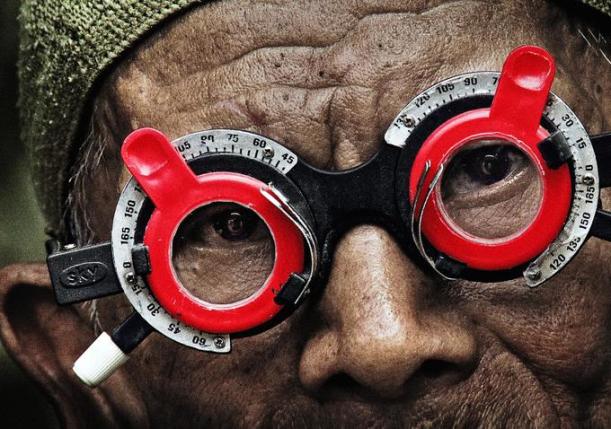We continue to call them “documentaries” for lack of a better word. But we are light years away from how “documentary” has generally been understood, not only in its classical format – an incisive voice heard over unexpected images – but also in those more narrative variants, starting with those offered by direct cinema.
Curiously, the year in which Venice confers a well-deserved Lifetime Career Award on Frederick Wiseman – though what a shame they showed not one of his films! – the festival is showing three films in its various sections that while being non-fiction offer a very different relationship to reality. If Wiseman’s films are the matured outcome of film as an instrument with which to understand society and its structures, the films of Joshua Oppenheimer, Ulrich Seidl, Franco Maresco (listed here in the order in which I saw them) call into question the very idea of what is real. Where Wiseman plays on the artifice of the invisible camera, the films by Oppenheimer, Seidl and Maresco play on the opposite principle: the prevalence of statements made head-on to camera with stunning insouciance.
In terms of the earlier and multi-award winning The Act of Killing, The Look of Silence constitutes a kind of necessary counterpoint: a return to the massacres perpetrated in Indonesia in 1965, accompanied by the brother of one of its victims, who, having observed the chilling performances assembled by Oppenheimer over the years, goes to meet the murderers, armed with a box full of spectacles (he is an optician by profession) and with something to say. Opening with a metaphor for sight, the film concludes on the impossibility of creating a dialogue between those so diametrically opposed: between those who have taken responsibility for horrendous crimes and indeed have made a good living from doing so, and he who has taken on the scars of pain and grief – both emotional and physical. The look of silence is all that is left to the victims, and hence what the film strives to work against.
Im Keller deploys itself in more horizontal mode, equalizing a plethora of odd characters, and exploring what they get up to in their basements. The film’s thesis is that the basement is where all that is removed from the surface (of society) finds its own form of expression: inveterate hunters, alcoholic musicians, opera lovers with shooting target galleries, dominatrixes and submissives exhibit themselves to camera with disconcerting candor. In this panoply of the bizarre, Seidl remains faithful to his own style of filmmaking, manipulative and provocative, able to approach the unapproachable.
More difficult to summarize in just a few lines, Belluscone, una storia siciliana is a mockumentary investigation undertaken by the critic Tatti Sanguineti of a film that Maresco wanted, but failed, to make, about the “Sicilian” rise of the Berlusconi myth. The Italian politician remains present, but in the background, as the subject of a song, of the unconditional admiration of the citizenry. Once again Maresco’s register is that of the grotesque, this time laden with an irony that is difficult to decipher, that unlocks a reading of the country that is Italy. Once again the abnormality of his characters – pseudo TV freaks -– becomes a filter through which to discern the abnormality of a whole society.
However different they may be in genesis or style, the three films are fascinating in the way they find characters, situations, places in the folds of reality that short-circuit the idea of society which the real is supposed to articulate. Like the best fiction –maybe even more so – they are profoundly unreal. And yet all three have the ambition, the presumption, the obsession to intervene in reality, modifying its perception or shaking up our vision of reality.
Here too, comparison with Wiseman can be illuminating. Where the American filmmaker, working through montage, constructs a discourse that gradually lays bare the basic fundamental rules of a given institution, Maresco, Oppenheimer, Seidl fling in our faces the brute power of the scene, the face of the freak, the words that disconcert. Wiseman works to create the conditions for recognition (in the sense of Greek drama’s anagnorisis), in a typically intellectual fashion; at the end of the film the distance between the watching subject (us) and what is watched (the other) is reduced, at least to some extent. Seidl’s approach to filmmaking does not seek to reduce such distances, but rather, exacerbates them; and in so doing does not hesitate to reduce the complexity of the real to a showcase of vices and virtues. At the end of the screening the distanciation is so extreme that it makes you wonder if what you have just been watching might actually be fiction: which would be one way of justifying the fact of spending over an hour in the company of a SM couple or a devout Nazi. Contrast is the dramatic principle at the basis of Oppenheimer and Maresco’s work. In both cases cinema is not an instrument that brings the subject closer but one that distances it, that exposes the unbridgeable distances present in society. All things considered, what is striking is the way the viewer is under attack, along with his/her innate desire to accommodate to the positions of the individuals filmed: the criminals of Suharto’s regime are too obtusely abject, Maresco’s protagonists too simply obtuse. In either case the only possible way to accept them is to make them into fictional characters, thus safeguarding against a reality that unfortunately exceeds one’s worst expectations.
Carlo Chatrian

